#9 in Uzbekistan
Baklava: Basic Information
Pronunciation
Alternative Name(s)
Dish Type
Course
Mealtime
Popular Variations
- Sütlü Nuriye
- Şöbiyet
- Gaziantep Baklava
- Güllaç
- Fıstıklı Baklava
- Kestaneli Baklava
- Vişneli Baklava
- Saragli
- Persian Baklava
- Paklava (Armenian Baklava)
- Baku Pakhlava
- Ganja Pakhlava
- Guba Pakhlava
- Sheki Pakhlava (Or Sheki Halva)
- Ružice
- Uzbek Pakhlava
- Faisaliah
- Basma
- Bakalawa bil Jibne
- Bukaj Baklava
- Taj al Malek
- Asabi
- Asawer
- Baklawa (Algerian baklava)
Baklava: Origin and Region
Origin
Continent’s Region
- West Asia
- North Africa
- Southern Europe
Country’s Region
Associated Region
Baklava: Ingredients and Preparation
Main Ingredients
Main Cooking Method
Preparation Process
Baklava: A Deep Dive
Cultural Significance
Taste
Texture
Aroma
Color
Serving Style
- Cut into squares, diamonds, or rectangles
- Served on its own or with accompaniments
Serving Temperature
Accompaniment
- Extra nuts, tea, Arabic coffee, fresh fruits, Ramadan desserts
- In Turkey: Kaymak (clotted cream), ice cream
Occasions
Seasons
Special Diets
Calories
Popularity
- West Asia and Central Asia: Turkey, Iran, Azerbaijan, Israel, Lebanon, Syria, Iraq, Saudi Arabia, Uzbekistan
- Southern Europe: Greece, Bosnia, Romania
- North Africa and East Africa: Tunisia, Algeria, Egypt, Somalia
Popular Similar Dishes
- Strudel
- Mille-feuille
- Sfogliatelle
- Kadayif
Popular Dining Area
Baklava is a famous layered dessert of Ottoman origin, with filo (or phyllo) dough, nuts, and honey or syrup as the main ingredients. There are many variations of baklava around the world.
Countries famous for making this dessert include Turkey, Greece, Iran, Azerbaijan, and Armenia, among many others. Baklava is considered one of Turkey’s national dishes.
Continue reading to discover fascinating facts about baklava. I will introduce you to its regional variations, main ingredients, flavor profile, how to store baklava, the pros and cons of the desserts, common queries about baklava, and similar desserts.
Key Points
Baklava Images
What Is the Origin of Baklava?
Baklava dates back to the 8th century BC when ancient Assyrians created a dish of flatbreads filled with nuts.
But its modern version emerged in the royal kitchens of the Ottoman Empire in the 16th century, based on borrowings from ancient Roman, Arab, or Central Asian pastries.
Baklava eventually became popular in Ottoman cuisine and was introduced to many regions under imperial rule.
Therefore, various countries that are former Ottoman territories enjoy baklava, such as Israel, Iraq, Saudi Arabia, Tunisia, and Egypt. Even countries that didn’t experience Ottoman rule, such as Romania and Somalia, also love it.
Today, the layered filo pastry dessert is a must-have food offering for weddings, birthdays, and religious holidays in many countries, especially Christmas and Ramadan, the Islamic holy month of fasting.
Given its widespread popularity, baklava comes in countless variations that cater to various preferences.
What Are the Most Popular Baklava Variations?
Below are 24 well-known baklava variations in countries famous for the layered filo pastry dessert:
While diverse in culinary influences, those baklava variations are usually made from the same ingredients.
What is Baklava Made of?
Classic baklava uses the following 3 ingredients:
| Ingredients | Characteristics |
|---|---|
| Filo Dough | Paper-thin unleavened dough sheets stacked upon each other Usually brushed with butter or vegetable oil to Varies in the number of layers from place to place Can be replaced with puff pastry, tortillas, or crepes |
| Nuts | Common choices: pistachios, walnuts, almonds, and hazelnuts Chopped and sweetened to fill between the filo sheets Can be substituted with seeds, dried fruits, or cereals |
| Sugar Syrup or Honey | Typically scented with lemon juice or aromatics like cardamom, rose water, and orange blossom water |
Combining these ingredients together to make sweet and crunchy baklava is an elegant art.
How to Make Baklava?
The preparation of baklava involves the 4 steps below:
- Step 1: Making the syrup
Mix honey or a mixture of sugar and water with lemon juice and aromatics, such as flavored water, to create scented syrup. Some versions use both sugar and honey. - Step 2: Making the filling
Combine chopped nuts, sugar, and spices together for the filling. - Step 3: Assembling the baklava
Layer the filo pastry sheets in a baking pan, with one or many layers of chopped nuts between them. Cut the baklava into pieces of the desired shape before baking it. - Step 4: Completing the baklava
Finally, pour syrup over the filo pastry dessert and garnish it with extra nuts.
The process facilitates the harmonious blend of those premium ingredients into the fantastic flavor profile of baklava.
Why Is Baklava So Popular?
Baklava boasts a wonderful taste thanks to its premium ingredients. The Ottoman-origin dessert has the sweetness of honey, the nutty richness of nuts, and the fragrant notes from the flavorings.
In addition, the flaky and crunchy filo dough contributes to a pleasant mouthfeel.
Because those ingredients are rather costly, and baklava requires a lot of time and work, the layered filo pastry dessert is slightly expensive. Let’s learn how to make your baklava experience count, such as its best accompaniments.
What to Serve with Baklava?
Baklava goes well with the following 5 options:
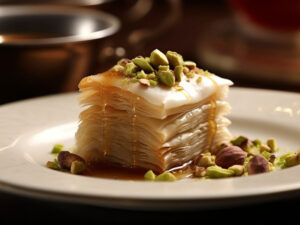
Extra nuts:
Traditional accompaniments for baklava.

Beverages:
Arabic tea and coffee.
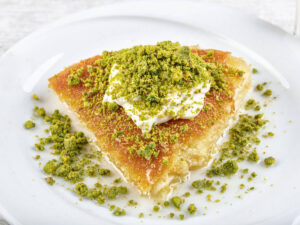
Kaymak (clotted cream) or ice cream:
Popular in Turkey.
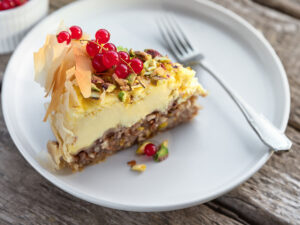
Fresh fruits:
Healthy accompaniments.
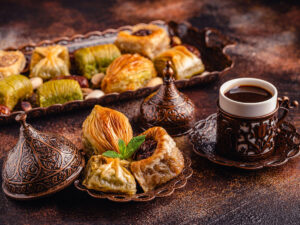
Ramadan desserts:
Such as halva, knafeh, Turkish delight, or kataifi. Baklava is sometimes served with these desserts at Iftar, the evening fast-breaking meal during Ramadan.
To experience all the joy baklava can give, learning how to store it correctly is of great importance.
How to Store Baklava Properly?
The best method of preserving baklava is to wrap it in waxed or parchment paper and put it in an airtight container.
While baklava doesn’t need refrigerating, putting it in the fridge prolongs the storage time. However, baklava will lose its crispiness and become chewier in that case.
The storage time of baklava is as follows:
- At room temperature: two weeks.
- In the fridge: two weeks to 1 month.
- In the freezer: 4 – 6 months.
To warm the filo pastry dessert, thaw it in the fridge for 6 hours or more, then heat it up in the oven or microwave.
Whether freshly baked or rewarmed, baklava is always an addictive treat that makes you come back for more. Therefore, keep in mind the nutritional profile of baklava to help moderate your consumption.
What Are the Health Benefits of Baklava?
Baklava is filled with nuts rich in protein and healthy fats, which can protect against chronic diseases like stroke and heart attack.
In addition, since baklava contains a large amount of sugar and carbs, it is a calorie-rich food that gives a quick energy boost, making it ideal for Ramadan, especially after a day of fasting.
However, whether baklava is good for health or not depends on the individual intake. Having a small or medium-sized serving of baklava will give many health benefits, but overeating will lead to excess calories, resulting in obesity and other health concerns.
On a related note, traditional baklava is neither vegan nor gluten-free, so people on vegan or gluten-free diets are unlikely to appreciate the Ottoman-origin dessert. Read on to discover more pros and cons of baklava.
Pros and Cons of Eating Baklava
Below is a complete list of the advantages and disadvantages of baklava:
Pros
Cons
Before wrapping up the examination of the pros and cons of baklava, I will address some frequently asked questions about the dessert for you.


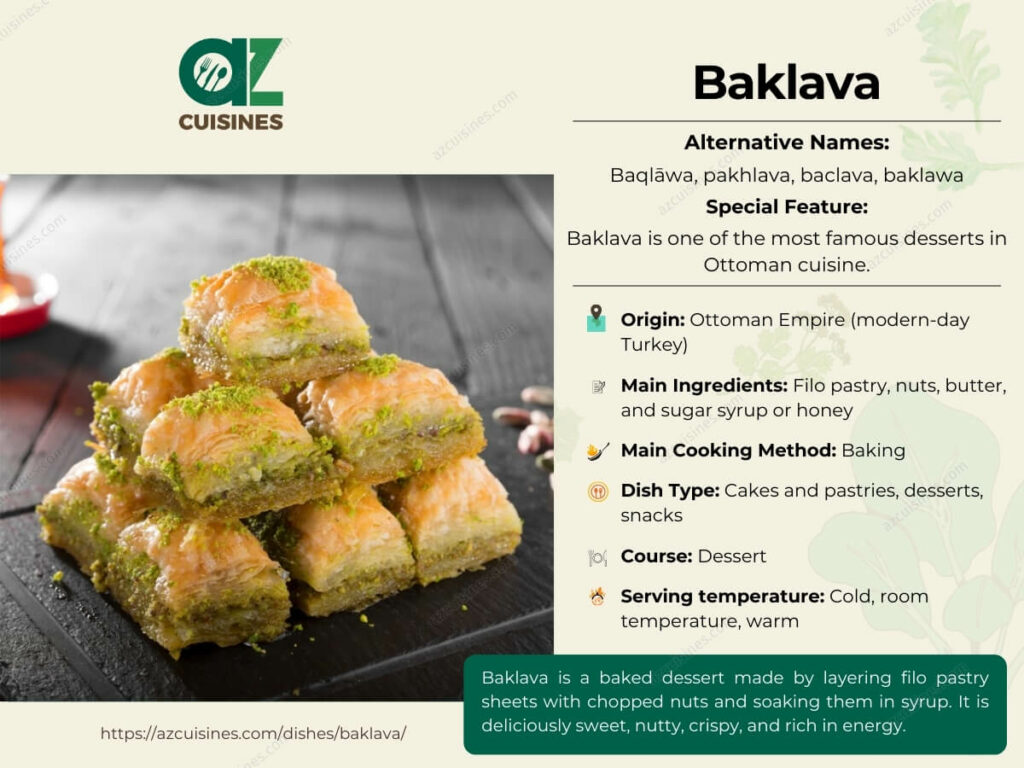
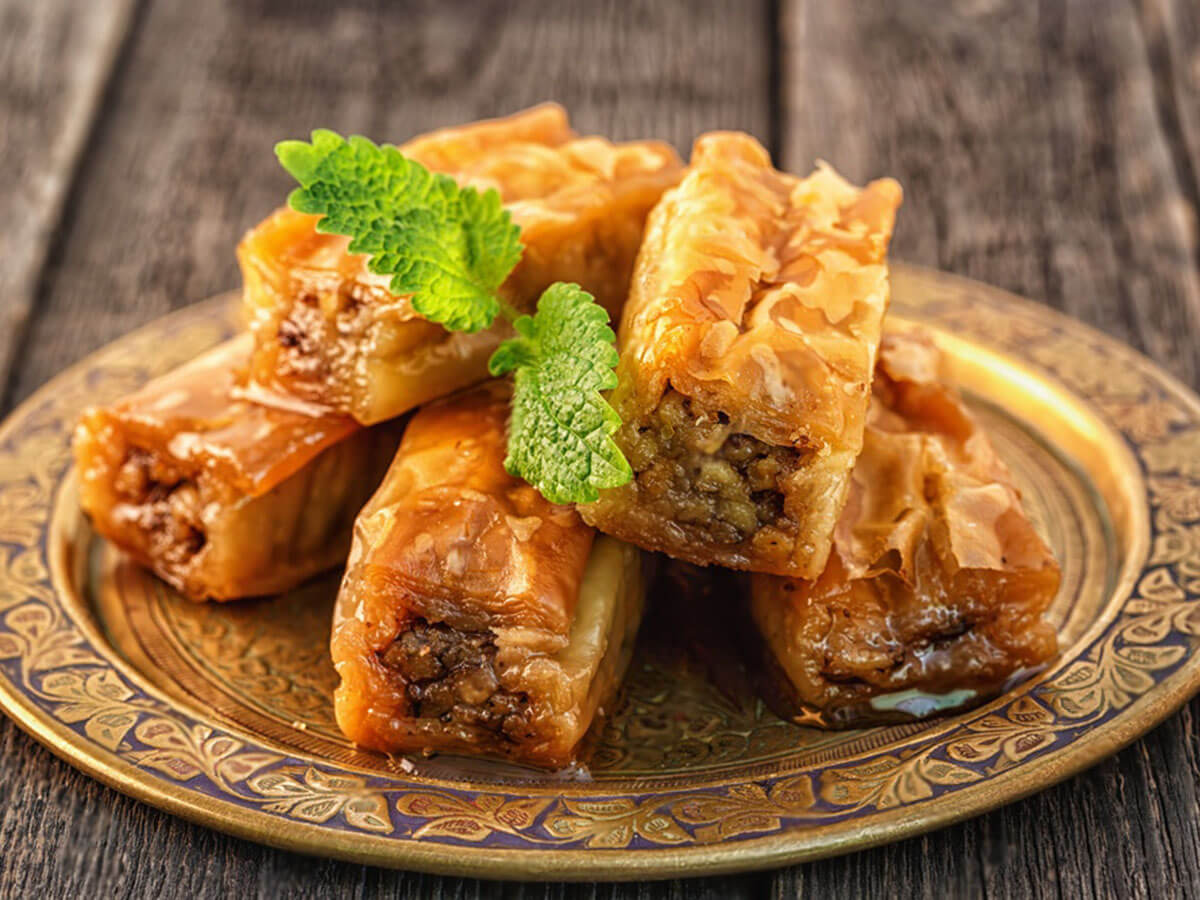
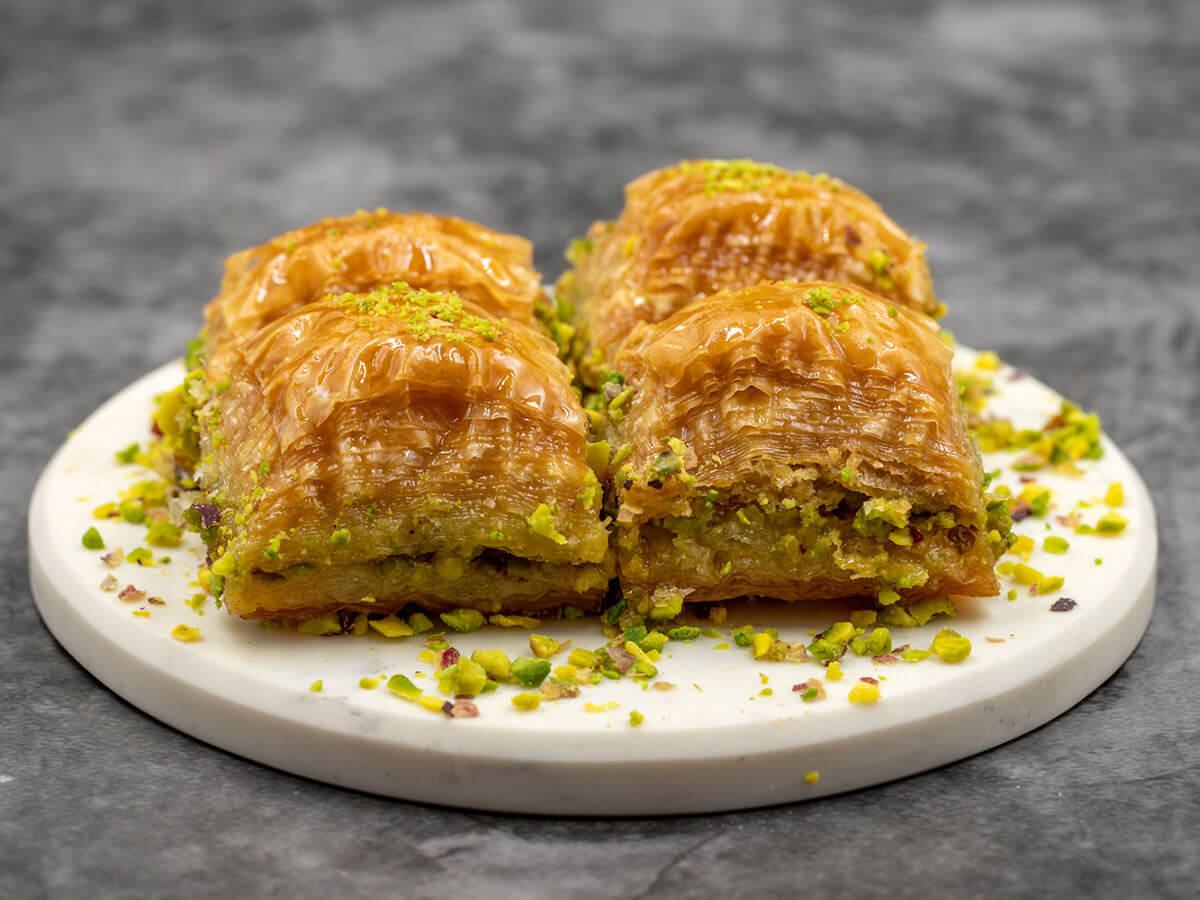
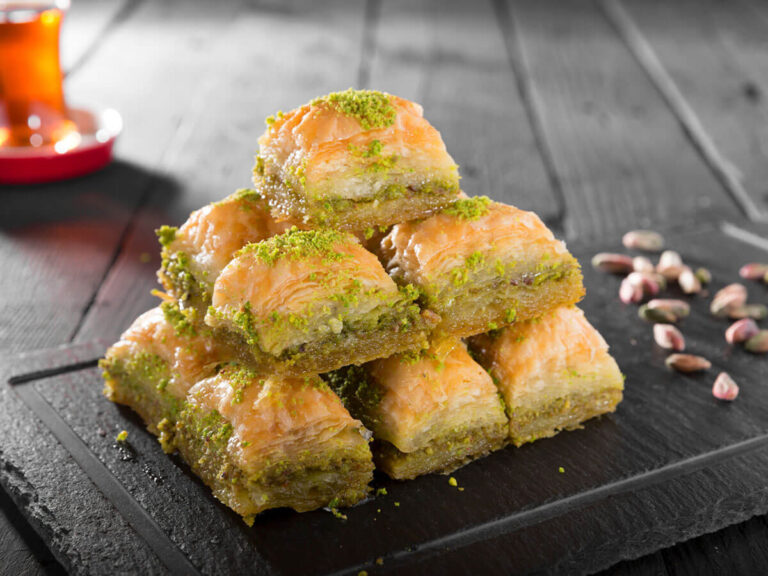
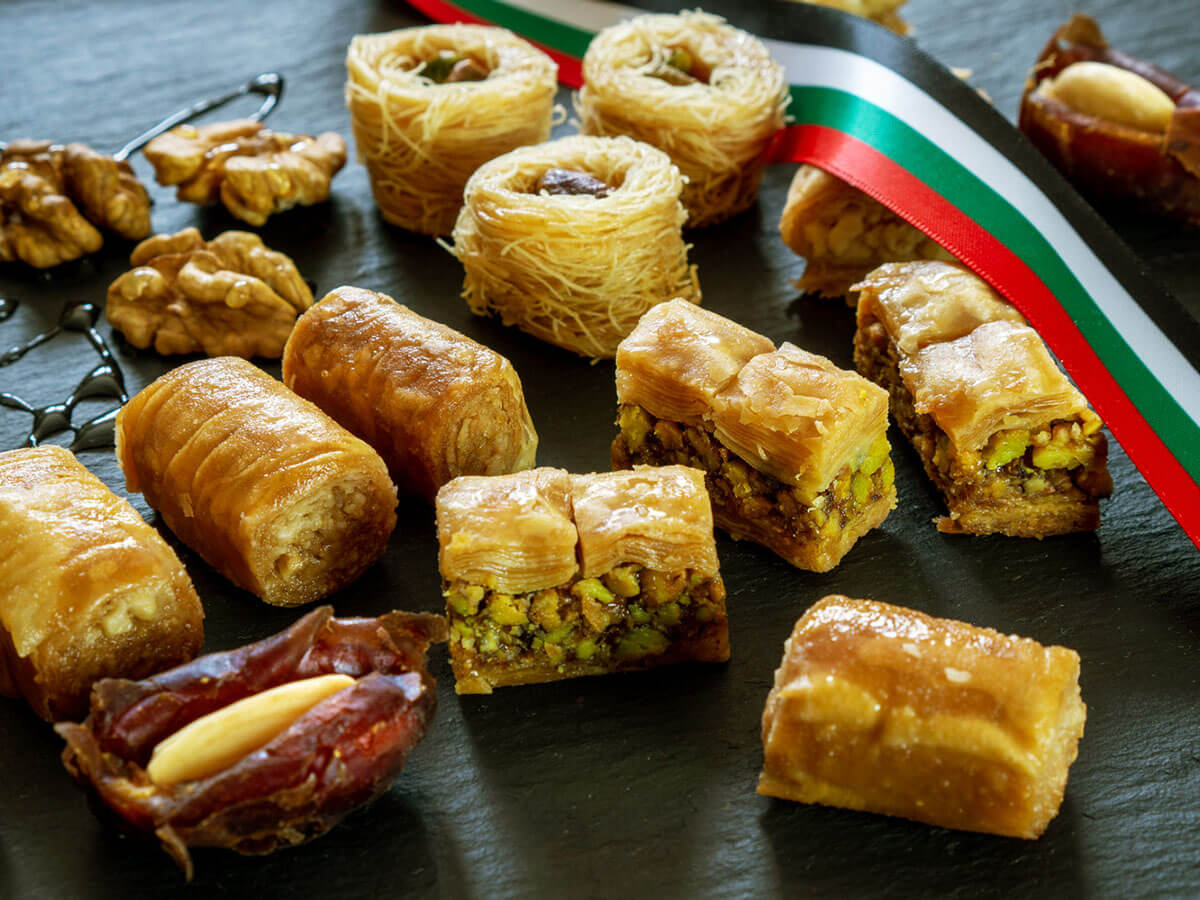
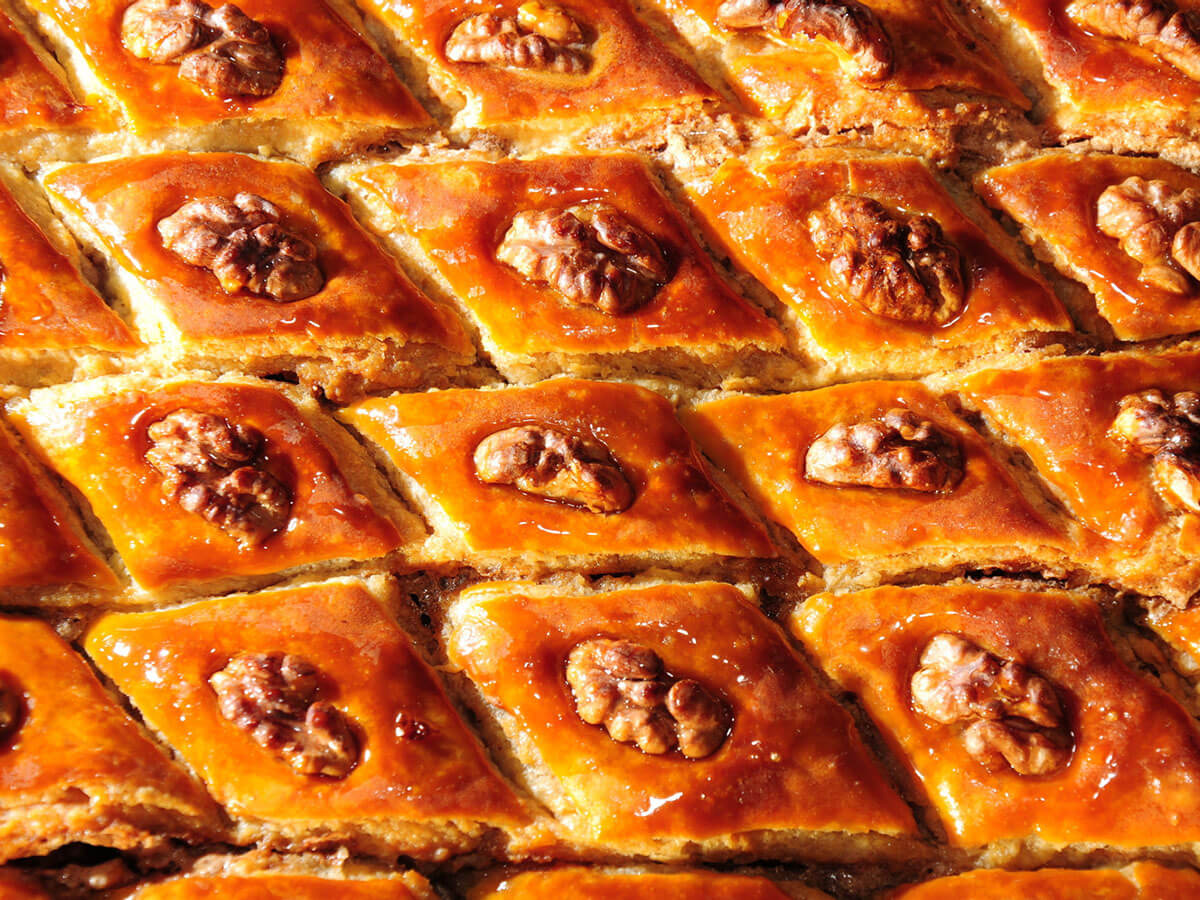
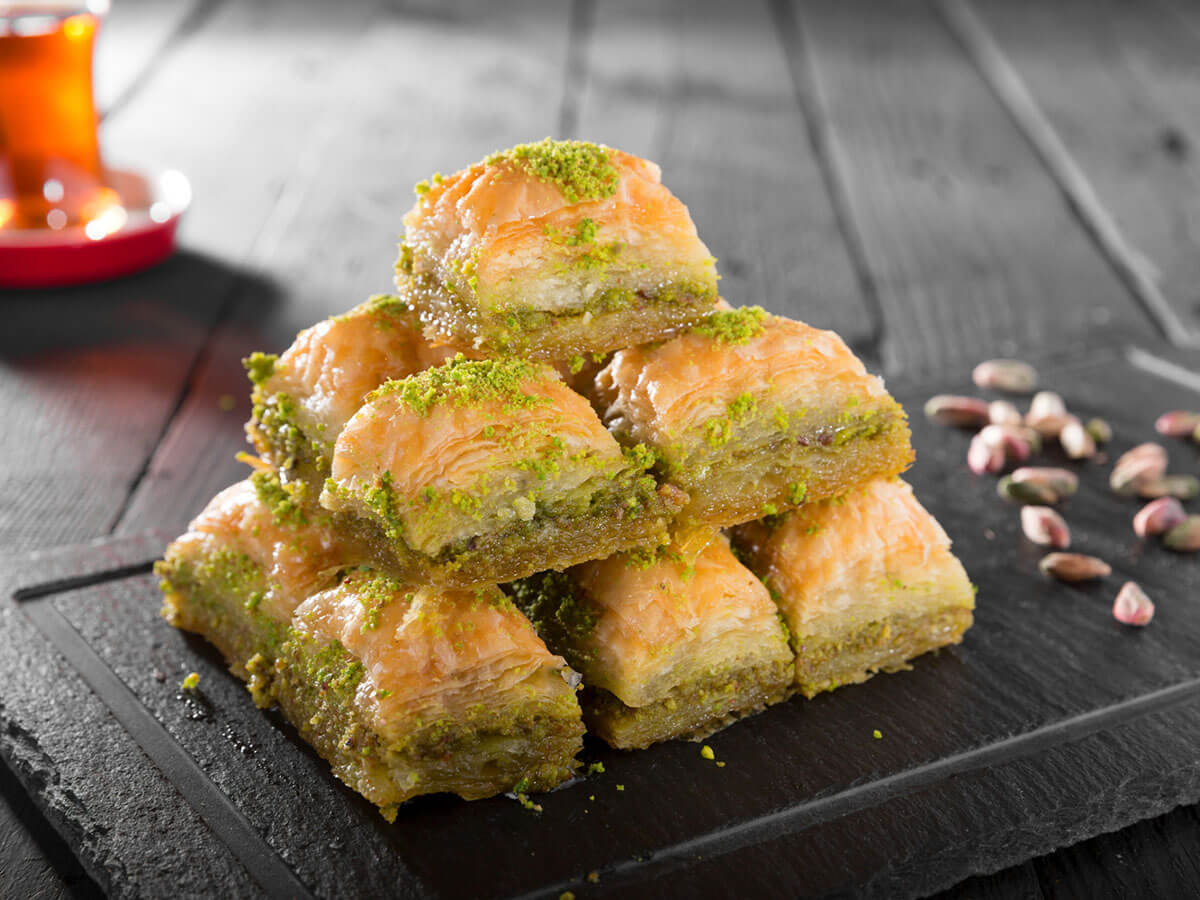
Adam Sam
Senior Food and Drink Editor
Expertise
Food Writer & Recipe Developer, Recipe Tester, Bartender, Cooking-video Maker, Editor In Chief
Education
Adam Sam, an experienced food writer and recipe developer, is passionate about blending diverse culinary traditions, national dishes, and innovative beverages, showcasing his proficiency in both traditional and modern recipe testing.
As the Editor-in-Chief, he elevates culinary content from street food to fine dining, focusing on Western cuisine and types of drinks at azcuisines.com, and is professional in creating engaging cooking videos that simplify complex dishes and ingredients.
His passion for food is evident in his writing, where he uniquely merges various cultures, traditions, and contemporary trends, skillfully combining classic recipes with modern cooking methods.